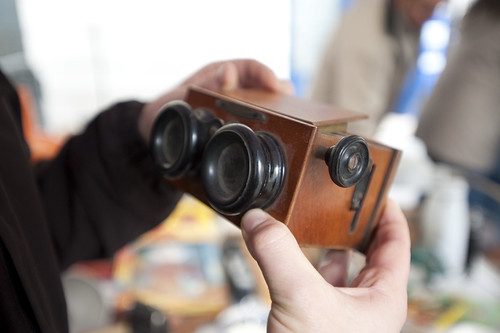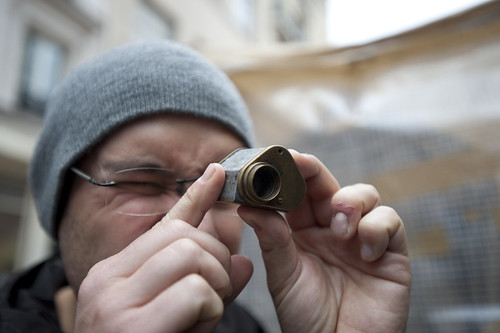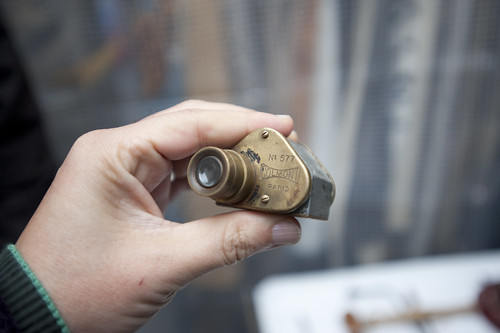A small collection of historic augmented reality devices, found during a rake through a flea market in Paris with fellow Urban Scout Nicolas Nova last Saturday. Mostly bashed up, broken things — but evocative devices that, when run up against all the excitement surrounding “Augmented Reality”, suggest more to me than the more typical, canonical — hold-my-flat-screen-mobile-device-up-in-front-of-me mode of operation.
Tactically, the evolution of mobile practices like this might learn from the everyday pre-historic rituals, such as gazing through a telescope which, in its infancy, was probably quite close to a kind of augmented reality. It allowed merchants to gaze to the horizon while sitting at port to see what ships were coming in, with what loads. The more speculating merchants could foresee shifts in the local markets because cotton was coming in and eek out their profits with the foresight brought to them courtesy of their expensive, privileged optical devices. A kind of future-seeing device used to their advantage.
Today’s augmented reality has none of that sparkle and magic. The visions of the AR future as best as I can tell is overturned by the fetish of the technology. This truly is a bad approach to making new kinds of worlds. The instrument comes first — a display, compact electronics, embedded compass and network connectivity — are what guide the vision and the “scenarios” (if you can call them that) entail something that basically is an expensive way to ask someone standing right next to you, who probably speaks a language you speak anyway — where the nearest public toilet is. Or where the metro stop is. Or in what direction the museum is. All of these things are problems that have been well-solved and need no tax imposed upon them like data roaming fees, or the inconvenience of a [[bad network/crap GPS signal/annoyance of dropping your $500 toy//&c]].
Augmented Reality in this mode of “design” is a bit like finding a nice door knob…and then looking for the house that looks good around it. Starting with the door knob — the instrumental technical stuff — is a really bad way to design a house, I think.
Why do I blog this? Poking and prodding at a more satisfying set of metaphors, language, histories for what a looking glass / viewmaster / binocular of the near future might be and what lessons it might learn from its prehistoric kin. I’m curious about the possibility of learning from the evolution and development and cultural valance of these earlier devices — considering them in the mode of a magical, exciting bit of technical kit from their time. But what did they do and how were they used? How much of the device and technical characteristics guided what they became, like today? Was someone walking around with some carefully, expensively constructed optics, not entirely sure what to do with them? Or not sure how to sell them to people? How were they to be assembled, technically speaking? What was the level of knowledge of combined optics — was it similar in its sophistication and arcane incantations like programming embedded devices and mobile phones today? What did it take for someone to use the telescope as something other than a device for starring at the moon or constellations? And other questions like this…what can be learned from shifting contexts, moving to historic moments, fictionalizing alternative possibilities for those histories, or fictionalizing the near future of these weird “augmented reality” speculations.
What might “augmented reality” augment besides directions to a public toilet?




Today’s augmented reality has none of that sparkle and magic